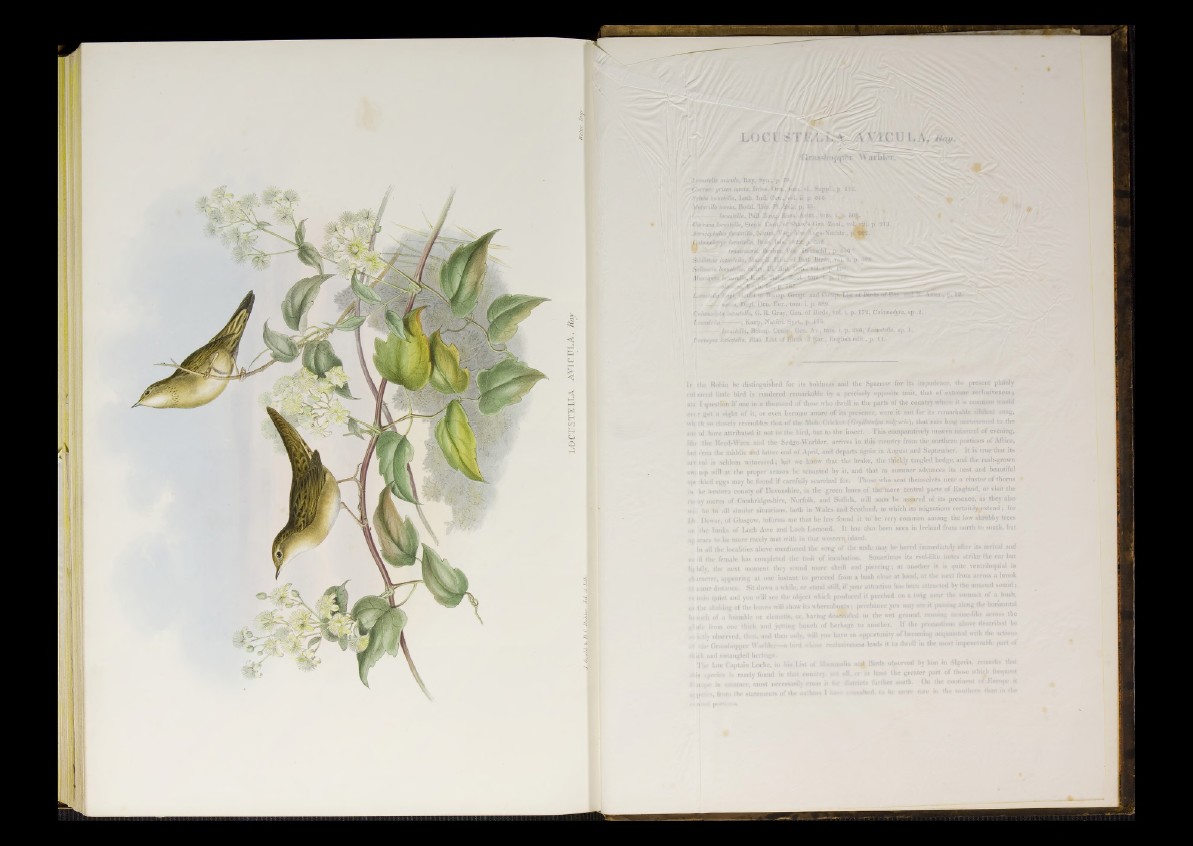
/ g i :
LOCI ST EC îs ^ k V J i C U L A; May.
'f I r a s s I i o f i ^ î ^ 'W a F b i e r . ~
}.\fnstella avicula, Ray, Syu., p. pb.
‘Gurruer. grísea navia, Jiriss.Orif., ton ». vi, Buppl.« p. 112.'
Sylvia locusteUa, Lath. Iatkf 0cÁ.J'jp't. ii. p 515. ,
Moia- illa itcaoia, Bodd. Tab. El./Snbi P- 35*
— locus telle, Palí. Koóg; Ross.-Ad*t, bu», i^p. 5i?§.
(ffr-ruca locusteUa,Stejjn. Cortt, of Shaw’s Gen Zool., voL¿riii. p. 213.
Aerocephalus Jlaviatilis, ^auiri.A’^^AloMvuga-N'aClitr., p. "8$2.
Lulamoberpe locustjefln, Boi y ipftsj 18 p«^CwC jtemhostrii
db Aixti. A o f Jrfroachl., g CK> ?
Sibihtrir locusteUa, t, of Brit. Birds, vol. ii. p. 9»». *v
^aéieuria locust'’! glÉjyí |L.
Ahtscipelá % < £s0$L Kyíí. p. í
- -
Á o e lK te lt^^g i^'O yM ^ ^ í ^ p , . Geogr. and tSBírrpa UiatoLiau-druf«»
| »<m«, Bujl. Oía. Éur., tona. i. p. 589.
G‘alatkod>jta: locusteUa, G. R. Gray,'Gen. of Birds, vol. i. p. 172, Calamodyta, sp. 2.
/ oeuslcUa, '—■---- , Kaup, Natürl. Syst, p. 115.
— Uinistella, Bdnap. Consp. Gen. Av., tora. i. p. 280, Loevstello, sp. 1.
Famopia locusteUa, Blas. List of Mrdl of Ear., English edit., p. 11.
If the Robin be distinguished for its boldness and the Sparrow for it* impudence, the present plainly
col Hired little bird is rendered remarkable by a precisely opposite trait, that of extreme reclusiveness;
am I question if one in a thousand of thpse who dwell in the parts of the country where it is common would
ev< r get a sight of it, or even become aware of its presence, were it not for its remarkable sibilant song,
wh ch so closely resembles that of the Mole Cricket i hniifoiatyu vulgaris), that ears long accustomed to the
sor id bave attributed it not to the bird, but to the insect. This comparatively unseen minstrel of evening,
liii. the Reed-Wrcn and the Sedge-Warbler, arrives in this country from the northern portions of Africa,
bet veeti the middle and latter end of April, and departs again in August and September. It is true that its
art va} is seldom witnessed; but we know that the brake, the thickly tangled hedge,and the rush-grown
swi mp will a t the proper season be tenanted by it, and that as summer advances its nest and beautiful
sin ;kled eggs may be found if carefully searched for. Those who seat themselves near a cluster of thorns
in he western county of Devonshire, in the green lanes of the more central parts of England, or visit the
rv,. I,y mercs of Cambridgeshire, Norfolk, and Suffolk, will soon be assured of its presence, as they also
wi I be in all similar situations, both in Wales and Scotland, to which its migrations certainlj^xtend ; for
I), Dewar, of Glasgow, informs me that he has found it to be very common among the low shrubby trees
w the banks of Loch Awe and Loch Lomond; It has also been seen in Ireland from north to south, but
he sears to be more rarely met with in that western, island.
[n all the localities above mentioned the song of the male may be heard immediately after its arrival and
i s til the female has completed the task of incubation. Sometimes its reel-like notes strike the ear but
1« fitly, the next moment they sound more shrill and piercing; at another it is quite ventriloquial in
character, appearing at one instant to proceed from a bush close at hand, at the next from across a brook
a t «ome distance. Sit down a while, or stand still, if your attention has been attracted by the unusual sound ;
re itatn quiet and you will see the object which produced it perched on a twig near the summit of a bush,
of the shaking of the leaves will show its whereabouts ; perchance you may see it passing along the horizontal
i t Lj ich. of a bramble or clematis, or, having descended to the wet ground, running mouse-like across the
, [,f<; from one thick and jutting bunch of herbage to another. If the precautions above described be
... |;j ,jv observed, then, and then only, will you have an opportunity o f becoming acquainted with the actions
of rhe Grasshopper WarMer—a bird whoso reclusiveness leads it to dwell in the most impenetrable part of
thick and entangled herbage.
Tin; late Captain Loche, in bis List or Mammalia and Birds observed by him in Algeria, remarks that
»fit species k rarely found in that couutrj. vet .ill, or at least the greater part of those which frequent
1 ,n in «mimer, must necessarily cross it Sc- districts further south. On the continent of,Europe it
J p ^ r s , from the statements of the authors I bare cooaaltcd, to he more rare in the southern than in the